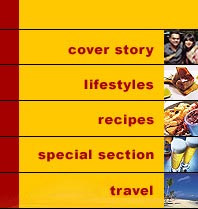


 Chocolate Boy!
Chocolate Boy!
Talk about getting lucky. Chef Gael Etrillard, Technical Advisor, Barry Callebaut, Asia Pacific, has his chocolate cake and eats it too – every day at that! Barry Callebaut is the world’s leading manufacturer of high quality cocoa and chocolate products. Around the globe, Barry Callebaut Chocolate Academies offer practical and theoretical courses for chocolate artisans: pastry chefs, confectioners, bakers and caterers who want to improve their skills in working with chocolate and learn about new trends, techniques and recipes. Chef Gael was in Bombay to get the academy here going, and to demonstrate all the amazing things you can create with Callebaut chocolate.
He also adds another ingredient. “Love,” he says almost bashfully. “It is quite important to add a bit of passion when you are cooking with chocolate.” Gael did his “culinary education” in the champagne area of France. After two years of apprenticeship in pastry, he spent one more year at school for chocolate specialization. Gael started his career as a pastry chef in a Michelin star restaurant in the French countryside. Since then he has been working in various Michelin star restaurants in France and England, and at 5 star hotels in China, Japan, Hong Kong and Singapore. He joined Barry Callebaut in 2007 as Technical Advisor. Based in Singapore, and in charge of the Singapore academy, he conducts classes on a monthly basis and travels to promote the brand and consult with hotels, cake shops, restaurants and develops recipes for customers.
He equally enjoys the art of creation. “There is so much you can do with chocolate – pralines, show pieces, displays, cakes, and all kinds of things. It is challenging to meet the differing needs of our clients. Those who are into buffets and banquets need chocolate desserts that will not spoil for three to four hours. Smaller gourmet restaurants want novelty and freshness. So I create as per the client’s needs. Of course, having great raw material with Callebaut chocolate helps,” he explains. Barry Callebaut, as a company, works with chocolates based on their origin (like one might with wine or coffee). So it encourages chocolate gourmands to savour the essence of exceptional chocolate – from Ecuador, Ghana, Arriba, Sao Thome or Madagascar – with their variety or origin based products. Barry Callebaut academies teach chocolate fans about the difference between real chocolates and ‘compound’, and how to work with real chocolate, from recipes to techniques. The academies are state-of-the-art and world renowned among the F&B industry. An annual competition sees the best pastry chefs globally competing for top honours at the academy’s annual event. Their first academy in India underlines the importance of the country as an emerging gourmet food market. The academy will cater to professional chefs, artisans and also to entrepreneurs and those really interested in chocolate, and Chef Gael sees himself coming here more often. As it is, he has been on something of a chocolate trail through the world and is happy to share the highlights of his journey. “In Belgium, the size of their praline is bigger than it is in France, and far more buttery. Factory made chocolates are also excessively buttery and sweet. If you are in Europe, you must go to the small chocolatiers who make their chocolates in the back of the shop. These are by far more fresh and healthy,” he exhorts. Did he say healthy? As if chocolate can ever be! “Oh, yes,” he asserts, “dark chocolate is not fattening and is actually good for you. Look at me – I may not be very fit but I’m fine for someone who eats up to a kilo of chocolate every day. But my chocolates are made with very little fat. Natural cocoa butter the body can assimilate,” he explains.
He rues the fact that milk chocolate reigns supreme in India. However, he hasn’t been averse to introducing dark chocolate at his workshops and confesses, “People say they like dark chocolate but find it bitter. In China, the reverse is true. The Chinese find milk chocolate pralines too sweet and prefer the dark variety. In India, I’ve never heard anyone say something’s too sweet. In fact, the sweeter the better!” |

Home Page
 “I enjoy developing new recipes with chocolate,” he beams, “and it is important to focus on technical aspects like increasing the shelf life of the products, while keeping the texture and flavour intact. At what temperature does one store a chocolate product, for instance – all of this needs to be worked out.”
“I enjoy developing new recipes with chocolate,” he beams, “and it is important to focus on technical aspects like increasing the shelf life of the products, while keeping the texture and flavour intact. At what temperature does one store a chocolate product, for instance – all of this needs to be worked out.” If you think that takes the edge off your indulgence, banish the idea. Most commercially made chocolate, even the dark variety, is loaded with fat, generally butter. Says Gael, “Butter kills the taste and fills you up. After the second or third piece you feel very full, and a little sick. But chocolate made with very little fat (not more than 12 per cent) and high quality cocoa won’t fill you up and leave your mouth waxy.”
If you think that takes the edge off your indulgence, banish the idea. Most commercially made chocolate, even the dark variety, is loaded with fat, generally butter. Says Gael, “Butter kills the taste and fills you up. After the second or third piece you feel very full, and a little sick. But chocolate made with very little fat (not more than 12 per cent) and high quality cocoa won’t fill you up and leave your mouth waxy.”